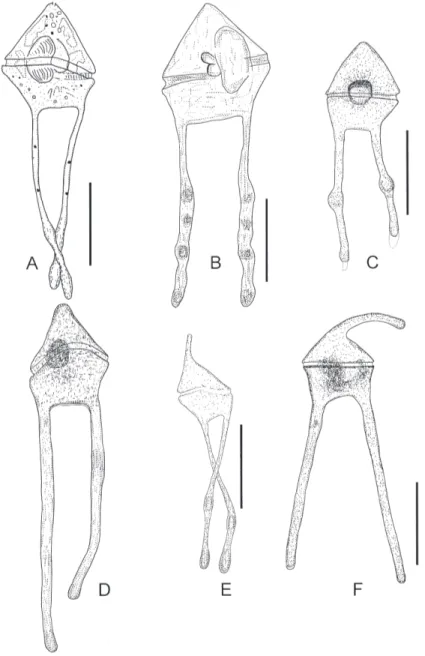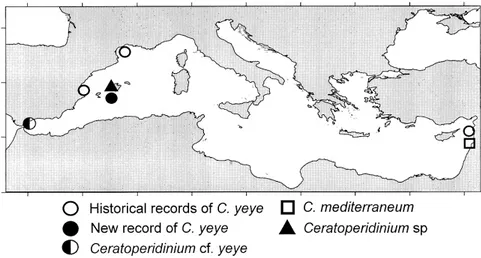HAL Id: hal-03205093
https://hal.sorbonne-universite.fr/hal-03205093
Submitted on 22 Apr 2021HAL is a multi-disciplinary open access archive for the deposit and dissemination of sci-entific research documents, whether they are pub-lished or not. The documents may come from teaching and research institutions in France or abroad, or from public or private research centers.
L’archive ouverte pluridisciplinaire HAL, est destinée au dépôt et à la diffusion de documents scientifiques de niveau recherche, publiés ou non, émanant des établissements d’enseignement et de recherche français ou étrangers, des laboratoires publics ou privés.
RECORDS OF CERATOPERIDINIUM MARGALEF
(DINOPHYCEAE) FROM THE MEDITERRANEAN
SEA
F Gómez, M Abboud-Abi Saab
To cite this version:
F Gómez, M Abboud-Abi Saab. RECORDS OF CERATOPERIDINIUM MARGALEF (DINO-PHYCEAE) FROM THE MEDITERRANEAN SEA. Vie et Milieu / Life & Environment, Obser-vatoire Océanologique - Laboratoire Arago, 2003, pp.43-46. �hal-03205093�
RECORDS OF CERATOPERIDINIUM MARGALEF (DINOPHYCEAE)
FROM THE MEDITERRANEAN SEA
F. GÓMEZ
*, M. ABBOUD-ABI SAAB
** *Department of Aquatic Biosciences, Graduate School of Agriculture and Life Sciences,The University of Tokyo, 1-1-1 Yayoi, Bunkyo, Tokyo 113-8657, Japan
**National Center for Marine Sciences, P.O. Box 534, Batroun, Lebanon
fernando.gomez@fitoplancton.com mabisaab@cnrs.edu.lb CERATOPERIDINIUM DINOFLAGELLATE DINOPHYCEAE PHYTOPLANKTON MEDITERRANEAN SEA
ABSTRACT. – Records of dinoflagellates of the rare genus Ceratoperidinium Mar-galef ex Loeblich III are reported from the Mediterranean Sea. C. yeye MarMar-galef was collected from the Bay of Palma de Mallorca (Balearic Is.) and C. cf. yeye from the Alborán Sea. From the Lebanese coastal waters, C. yeye was also reported and C. mediterraneum Abboud-Abi Saab. Other taxon, Ceratoperidinium sp., characte-rised by a distinct elongate apical process, is reported from the Bay of Palma de Mallorca. These species were collected from neritic and epipelagic waters and usually associated with phytoplankton post-bloom conditions.
CERATOPERIDINIUM DINOFLAGELLÉ DINOPHYCEAE PHYTOPLANCTON MER MÉDITERRANÉE
RÉSUMÉ. – Des données sur un genre rare de Dinoflagellé Ceratoperidinium Mar-galef ex Loeblich III de Méditerranée sont exposées. C. yeye MarMar-galef a été trouvé dans la Mer d’Alborán et la Baie de Palma de Mallorca (Iles Baléares). Dans les eaux côtières libanaises, C. yeye et C. mediterraneum Abboud-Abi Saab ont aussi été recoltés. Ceratoperidinium sp., caractérisé par un prolongement apical distinct, a été signalé dans la Baie de Palma de Majorque. Ces espèces ont été collectées dans des eaux néritiques, épipélagiques et souvent associées aux conditions d’un post-bloom de phytoplancton.
Dinoflagellates are well represented in the oligotrophic waters of the Mediterranean Sea. De-spite the relative high number of studies performed in the Mediterranean Sea, some taxa are rarely re-ported and information on their ecology and distri-bution is scarce. This is the case for the species of the genus Ceratoperidinium.
The systematic position of this genus, which shape is reminiscent of peridinialeans and brachydiniaceans, remains uncertain. Ceratoperidinium has been consid-ered as a thecate dinoflagellate of the order Peridiniales (Loeblich III 1982, Sournia 1986), but thecal plates have not been observed. According to Fensome et al. (1993), the rigid wall may be evidence of a pellicle. These authors placed this genus in the Ptychodiscales as an athecate dinoflagellate.
Ceratoperidinium yeye Margalef ex Loeblich III The type species of the genus Ceratoperidinium was described from one individual in the Spanish Mediterranean coastal waters (Margalef 1969). The
species presented a total length of 184 µm (63µm excluding the antapical appendices) and a transversal diameter of 50µm (Fig. 1A). This taxon was re-described as Ceratoperidinium margalefii by Loeblich III (1980) due to the lack of Latin di-agnosis.
Later, Abboud-Abi Saab (1989) reported one specimen of C. yeye found in November 1988 at 5 m depth in the Lebanese coastal waters (33o 57’
34’’N, 35o 35’ 47’’E). The Lugol fixed specimen
was collected from waters with a temperature of 22oC, salinity 39.53, nitrate 0.26µM and phosphate
0.04 µM. Mainly diatoms composed the surround-ing phytoplankton assemblage, reachsurround-ing an abun-dance of 6.1 cells ml–1and dinoflagellates (mainly
athecate forms) reaching an abundance of 3 cells ml-1. The total length of the specimen was 236µm,
67µm excluding the appendices and the transdiameter was 59 µm. The cell size excluding the antapical appendices represented 25% of the to-tal length. This specimen presented differences with the type species such as bigger size and protu-berances that started at the 1/3 from the proximal
part, distributed regularly towards the tips of the antapical appendices (Fig. 1B).
Velásquez (1997) reported two records of C. yeye in the Gulf of Lions (NW Mediterranean Sea) in February 1988.
During a survey carried out in September 1999, one specimen that resembles C. yeye was observed at 20 m depth in the NW Alborán Sea (36o05’N,
05o12’W) from Lugol fixed water samples
(Fig. 1D). Temperature was 17.3oC, salinity 36.77,
nitrate 0.15µM and phosphate 0.03µM. The microphytoplankton assemblage was dominated by diatoms that reached an abundance of 7.7 cells ml–1,
mainly Dactyliosolen fragilissimus, Leptocylindrus
danicus, L. minimus and Pseudo-nitzschia spp, whereas dinoflagellates reached an abundance of 2.6 cells ml–1 dominated by Gymnodinium
catenatum. The observed phytoplankton assem-blage corresponded to post-bloom conditions, in contrast with an assemblage dominated by Chaetoceros curvisetus more typical under the eutrophic conditions in this area (Gómez et al. 2000).
No size measurements of this specimen were performed. Cell size excluding the antapical appen-dices represented 29% of the total size whereas in the Margalef’s figure this ratio was 34%. The antapical appendices were thicker than those
44 GÓMEZ F., ABBOUD-ABI SAAB M.
Fig. 1. – Line drawings of the records of Ceratoperidinium spp in the Mediterranean Sea. A, The type species, Cerato-peridinium yeye Margalef, adapted from Margalef (1969). B, C. yeye from the Lebanese coastal waters. C, C. yeye col-lected from the Bay of Palma de Mallorca (Balearic Is.). D, Ceratoperidinium cf. yeye recorded from the NW Alborán Sea. E, Ceratoperidinium mediterraneum Abboud-Abi Saab from the Lebanese coastal waters. F, Ceratoperidinium sp. collected from the Bay of Palma de Mallorca. Scale bar: 50 µm.
shown in Margalef (1969) and protuberances were not observed along the appendices.
In October 2001, a specimen of C. yeye was ob-served at 10 m depth in the Bay of Palma de Mallorca (Balearic Is.) (39o32’N, 2o36.3’E) from
Lugol fixed water samples. The cell was 131 µm long (51µm excluding the appendices) and the transdiameter was 42 µm (Fig. 1C). The antapical appendices were also thicker than those in Margalef’s drawing and both of them presented clear protuberances in the middle of the appendices.
Ceratoperidinium mediterraneum Abboud-Abi Saab
Abboud-Abi Saab (1989) described this species from the Lebanese coastal waters from one speci-men. The main characteristic of this taxon in com-parison to C. yeye is the presence of a tip-rounded tubular apical (capitate) process (Fig. 1E). The to-tal length was 134µm, 46µm excluding the appen-dices and the cingulum was 42 µm width (cell size excluding the antapical appendices represented 34% of the total size). The type species was found in July 1982 at 5 m depth in a coastal station (34o00’50’’N, 35o30’40’’E). The temperature was
27.2oC, salinity 39.2, nitrate 0.11µM and
phos-phate 0.03µM. The phytoplankton assemblage cor-responded to spring post-bloom conditions domi-nated by diatoms (mainly Dactyliosolen fragi-lissimus) reaching an abundance of 23.6 cells ml-1
whereas the abundance of dinoflagellates was low (0.32 cells ml–1). In October 1988, at the same
sta-tion and the same depth, another specimen was col-lected with a total length of 137µm (55µm exclud-ing the appendices) and the cexclud-ingulum was 47 µm width. Cell size excluding the antapical appendices represented 40% of the total size. This specimen was collected from waters with a temperature of 26.6oC and a salinity of 39.3.
Ceratoperidinium sp
In November 2001, one specimen of the genus Ceratoperidinium was collected in the Bay of Palma de Mallorca (Balearic Is.) at 10 m depth. The cingulum diameter was 39 µm width and 112µm of total length (including antapical and api-cal appendices) (Fig. 1F). This taxon presented a distinctive curved apical process more elongate than that of C. mediterraneum. In Cerato-peridinium sp. the antapical appendices were thicker than those in C. yeye and C. mediterraneum and protuberances along the antapical appendices were not observed. These characteristics resemble the antiapical appendices of the specimen C. cf. yeye, collected from the Alborán Sea. Based on the
Table I. – Records of Ceratoperidinium spp, including historical records.
length of the apical process, C. mediterraneum ap-pears as an intergraded taxon between C. yeye and Ceratoperidinium sp.
Final remarks
As general trend, C. yeye, C. mediterraneum and Ceratoperidinium sp. seem to appear in coastal ters, being preferentially recorded from surface wa-ters and usually associated with phytoplankton post-bloom conditions. Most of the specimens were collected under thermophilic conditions (summer-autumn), however the records by Velásquez (1997) in the Gulf of Lions in winter prevent us to consid-ering Ceratoperidinium as a strictly warm-waters genus.
According to the available knowledge on the geographical distribution of Ceratoperidinium, these species can be considered as an exclusively Mediterranean taxa (Table I, Fig. 2). Despite the distinctive morphology, relative large size and be-ing preferentially found in the surface coastal wa-ters (more intensely studied), the records of these taxa are extremely low.
ACKNOWLEDGEMENTS. – The sample from the Alborán
Sea was provided by Dr H Claustre within the context of JGOFS-France PROSOPE programme. F.G. acknowled-ges the financial support by Spanish Ministry of Science and Technology and by the European Commission (ICB2-CT-2001-80002).
REFERENCES
Abboud-Abi Saab M 1989. Les Dinoflagellés des eaux côtières libanaises- Espèces rares ou nouvelles du phytoplancton marin. Leb Sci Bull 5(2): 5-16. Fensome RA, Taylor FJR, Norris G, Sarjeant WAS,
Wharton DI, Williams GL 1993. A classification of living and fossil dinoflagellates. J Micropaleontology Spec Publ 7: 1-351. Amer Mus Nat Hist, Sheridan Press, Hanover, PA.
Gómez F, Echevarría F, García CM, Prieto L, Ruiz J, Reul A, Jiménez-Gómez F, Varela M 2000. Micro-plankton distribution in the Strait of Gibraltar: cou-pling between organisms and hydrodynamic structures. J Plank Res 22: 603-617.
Loeblich AR III 1980. Dinoflagellate nomenclature. Taxon 29: 321-324.
Loeblich AR III 1982. Dinophyceae. In Parker SP ed, Synopsis and classification of living organisms, McGraw-Hill, New York. 1: 101-115.
Margalef R 1969. Composición específica del fitoplanc-ton de la costa catalano-levantina (Mediterráneo occi-dental) en 1962-1967. Inv Pesq 33: 345-380. Sournia A 1986. Atlas du phytoplancton marin. Vol. I:
Introduction, Cyanophycées, Dictyochophycées, Di-nophycées et Raphidophycées. Editions du C.N.R.S., Paris 219 p.
Velásquez ZR 1997. Fitoplancton en el Mediterráneo Noroccidental. Ph.D. Univ Politècn Catalunya, 272 +55 p.
Reçu le 16 avril 2002; received April 16, 2002 Accepté le 24 septembre 2002; accepted September 24, 2002

